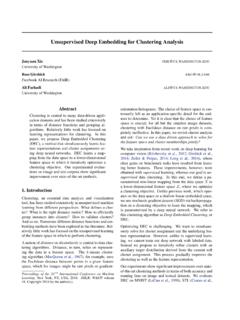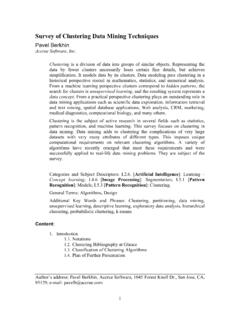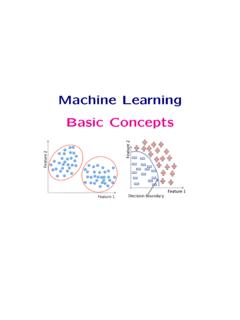Transcription of MACHINE LEARNING LABORATORY MANUAL - JNIT
1 MACHINE LEARNING LABORATORY MANUAL MACHINE LEARNING MACHINE LEARNING is a subset of artificial intelligence in the field of computer science that often uses statistical techniques to give computers the ability to "learn" ( , progressively improve performance on a specific task) with data, without being explicitly programmed. In the past decade, MACHINE LEARNING has given us self-driving cars, practical speech recognition, effective web search, and a vastly improved understanding of the human genome.
2 MACHINE LEARNING tasks MACHINE LEARNING tasks are typically classified into two broad categories, depending on whether there is a LEARNING "signal" or "feedback" available to a LEARNING system: Supervised LEARNING : The computer is presented with example inputs and their desired outputs, given by a "teacher", and the goal is to learn a general rule that maps inputs to outputs. As special cases, the input signal can be only partially available, or restricted to special feedback: Semi-supervised LEARNING : the computer is given only an incomplete training signal: a training set with some (often many) of the target outputs missing.
3 Active LEARNING : the computer can only obtain training labels for a limited set of instances (based on a budget), and also has to optimize its choice of objects to acquire labels for. When used interactively, these can be presented to the user for labeling. Reinforcement LEARNING : training data (in form of rewards and punishments) is given only as feedback to the program's actions in a dynamic environment, such as driving a vehicle or playing a game against an opponent. Unsupervised LEARNING : No labels are given to the LEARNING algorithm, leaving it on its own to find structure in its input.
4 Unsupervised LEARNING can be a goal in itself (discovering hidden patterns in data) or a means towards an end (feature LEARNING ). Supervised LEARNING Un Supervised LEARNING Instance based LEARNING Find-s algorithm EM algorithm Locally weighted Regression algorithm Candidate elimination algorithm K means algorithm Decision tree algorithm Back propagation Algorithm Na ve Bayes Algorithm K nearest neighbour algorithm(lazy LEARNING algorithm) MACHINE LEARNING applications In classification, inputs are divided into two or more classes, and the learner must produce a model that assigns unseen inputs to one or more (multi-label classification)
5 Of these classes. This is typically tackled in a supervised manner. Spam filtering is an example of classification, where the inputs are email (or other) messages and the classes are "spam" and "not spam". In regression, also a supervised problem, the outputs are continuous rather than discrete. In clustering , a set of inputs is to be divided into groups. Unlike in classification, the groups are not known beforehand, making this typically an unsupervised task. Density estimation finds the distribution of inputs in some space.
6 Dimensionality reduction simplifies inputs by mapping them into a lower- dimensional space. Topic modeling is a related problem, where a program is given a list of human language documents and is tasked with finding out which documents cover similar topics. MACHINE LEARNING Approaches Decision tree LEARNING : Decision tree LEARNING uses a decision tree as a predictive model, which maps observations about an item to conclusions about the item's target value. Association rule LEARNING Association rule LEARNING is a method for discovering interesting relations between variables in large databases.
7 Artificial neural networks An artificial neural network (ANN) LEARNING algorithm, usually called "neural network" (NN), is a LEARNING algorithm that is vaguely inspired by biological neural networks. Computations are structured in terms of an interconnected group of artificial neurons, processing information using a connectionist approach to computation. Modern neural networks are non-linear statistical data modeling tools. They are usually used to model complex relationships between inputs and outputs, to find patterns in data, or to capture the statistical structure in an unknown joint probability distribution between observed variables.
8 Deep LEARNING Falling hardware prices and the development of GPUs for personal use in the last few years have contributed to the development of the concept of deep LEARNING which consists of multiple hidden layers in an artificial neural network. This approach tries to model the way the human brain processes light and sound into vision and hearing. Some successful applications of deep LEARNING are computer vision and speech recognition. Inductive logic programming Inductive logic programming (ILP) is an approach to rule LEARNING using logic programming as a uniform representation for input examples, background knowledge, and hypotheses.
9 Given an encoding of the known background knowledge and a set of examples represented as a logical database of facts, an ILP system will derive a hypothesized logic program that entails all positive and no negative examples. Inductive programming is a related field that considers any kind of programming languages for representing hypotheses (and not only logic programming), such as functional programs. Support vector machines Support vector machines (SVMs) are a set of related supervised LEARNING methods used for classification and regression.
10 Given a set of training examples, each marked as belonging to one of two categories, an SVM training algorithm builds a model that predicts whether a new example falls into one category or the other. clustering Cluster analysis is the assignment of a set of observations into subsets (called clusters) so that observations within the same cluster are similar according to some pre designated criterion or criteria, while observations drawn from different clusters are dissimilar. Different clustering techniques make different assumptions on the structure of the data, often defined by some similarity metric and evaluated for example by internal compactness (similarity between members of the same cluster) and separation between different clusters.








